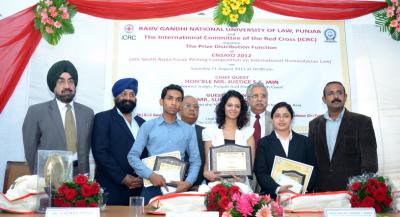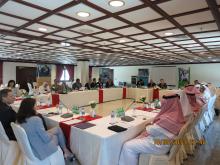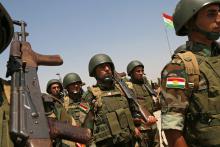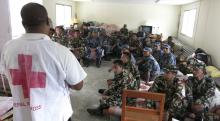Case prepared by Ran Yosef, LL.B student at IDC University, under the supervision of Adv. Yael Vias Gvirsman, Clinic Director, IDC University, and Jemma Arman and Isabelle Gallino, LL.M. students at the Geneva Academy.
A. INDIA: SCHOOLS IN JAMMU AND KASHMIR LEAD THE WAY IN PROMOTING HUMANITARIAN PRINCIPLES
[Source: ICRC Resource Centre, India: schools in Jammu and Kashmir lead the way in promoting humanitarian principles, 28 August 2009 - source not available]
Nineteen schools in Jammu and Kashmir have been trialling the "Exploring Humanitarian Law" programme (EHL), aimed at helping young people integrate the principles of humanity into their daily lives. ICRC communication coordinator Stéphanie Bouaziz met some of the creative and dedicated teachers who are finding space in their busy schedules to promote humanitarian values among their pupils.
“I didn’t expect such an encouraging reaction from the children. I was afraid they wouldn’t want to be bothered with an additional subject, but the outcome was so positive that I wish I had a much bigger classroom so I could accept all the children who want to take part!” explains Manmeet Bali, regional EHL trainer for the State. The enthusiastic and sparkly teacher is unstoppable as she explains the impact of the course on her 13 to 18-year-old pupils. “I believe that my role as a teacher is to help pupils make healthy choices for their futures. Choices that can prevent violence and high-risk behaviour. One must always remember that today’s pupils are tomorrow’s adults.”
The programme is also being used in the region’s girls’ schools, where it has been warmly welcomed. [...]
Viewing conflict from a humanitarian perspective
The EHL programme promotes humanitarian values in a very specific way, in that teachers let the children express themselves freely via debates, theatre, open discussions, etc.
“I believe that this interactive exercise has a great impact and helps de-stress the children when they discuss conflict situations. There is no room for politics in the classroom, only for humanitarian issues, "explains Mohamed Rafi, former director of school education in Kashmir.
Following the successful pilot programme, Jammu and Kashmir teachers want the EHL programme to cover as many schools as possible, so that it can reach every teenager in every corner of the state. This will be possible if EHL is integrated into the school curriculum and if there are sufficient teachers who have been trained to use the programme.
Jammu and Kashmir, a pioneer and an example?
Meenu Raghunathan, ICRC officer in charge of EHL for India, explained that the EHL pilot programme was now in the hands of the ministry of education, which was to consider integrating the programme into the secondary curriculum. Jammu and Kashmir was playing a pioneering role in south Asia, as the programme had never been taught in the region. “Until the authorities can take over complete responsibility for the course, the ICRC will continue to provide technical support and resource materials. Once the programme is implemented, I am convinced that many regions will consider Jammu and Kashmir an example to follow.”
B. TEACHING INTERNATIONAL HUMANITARIAN LAW: AN OVERVIEW OF AN ICRC DISSEMINATION PROGRAMME IN INDIA
[…]
Educational planners in the various South Asian countries have by and large agreed to include international humanitarian law in law and political science studies. Following the recommendations of the Association of Indian Universities in May 1998, most of the Indian universities have included an international humanitarian law component in their undergraduate LL.B. programmes, which are conducted by the 550 law colleges affiliated to them. About 30 universities offer postgraduate courses in international law. Of these, some twenty universities offer a full optional course in international humanitarian law. Moreover, thirty-five universities in India offer a Master’s programme in defence and strategic studies, with an optional course on international humanitarian law. Most human rights postgraduate or diploma programmes include a course on international humanitarian law.
[…] The ICRC, through its Regional Delegation in New Delhi, is closely involved in promoting international humanitarian law in academic institutions in South Asia. Thus the delegation:
- regularly organizes a South Asian Teaching Session on international humanitarian law for postgraduate students and young university lecturers;
- supports research and publications in this field;
- publishes a journal on international humanitarian law; and organizes academic events on specific aspects of international humanitarian law, such as the International Criminal Court, the 1977 Additional Protocols, the issue of anti-personnel landmines, etc.
The delegation also accepts students for internships, has established a documentation centre on its premises, supports libraries of academic institutions by providing publications on international humanitarian law, holds moot court and essay-writing competitions and arranges other promotional events. It regularly organizes training programmes in international humanitarian law for academic staff teaching law, international relations, human rights, etc. who give courses on the subject at undergraduate and postgraduate levels. Since 1999, together with the Indian Academy of International Law, it has launched a postgraduate diploma programme in international humanitarian law.
It must be stressed that as a rule these activities of the ICRC Delegation in New Delhi are conducted in collaboration with universities and other educational institutions in the countries concerned, and also with academic societies. Academic institutions have generally shown a keen interest in introducing international humanitarian law into higher education. As a result, there is considerable awareness of its importance among the academic communities in South Asia.
C. INTERNATIONAL HUMANITARIAN LAW: AN INDO-ASIAN PERSPECTIVE
[…] That the precepts [of IHL] are ingrained in the accumulated wisdom of all human civilizations is beyond dispute. All civilizations have converged in their acceptance of them. All that the Battle of Solferino of 1859 and Henry Dunant’s Red Cross movement have done in prompting such a widespread compassionate response has principally been to revive, intensify, build upon and sustain, on a continuous basis, those traditional precepts. […] They are not only products of the nascent European civilization of the post-Westphalian era. While Hugo Grotius spoke of temperamenta ac belli (humane moderation during war) in the early seventeenth century, the wise men of India and China discoursed on it some five thousand years ago.
[…]
Ancient India (up to AD 711)
In the early, pre-Vedic, period, when Indian society was organized in tribal communities, war between communities was “normal”, with no holds barred. Yet in many parts of India, the process of war was divided into five stages: 1. seizure of the enemy’s cattle; 2. mobilization for invasion; 3. bombardment of the enemy fortress; 4. actual fighting; and 5. victory. The seizure of cattle was an advance warning of an attack, and gave civilians and non-combatants time to seek shelter.
As society began to stabilize and became more and more politically and socially organized during the Vedic period, the Vedas, the Sastras and the epics of Ramayana and Mahabharata started prescribing or assuming the existence of laws and customs of war.
[…]
Methods of warfare
The credo of the ancient sages appears to have been that “a war for a righteous cause must be righteously conducted”. Combat must be between two warriors similarly placed. A warrior in armour should not fight with another without similar protection. […] He whose weapon has been broken, whose bowstring has been cut or who has lost his chariot should not be struck.
A principle of proportionality seems to have existed with regard to the use of weapons. Nagendra Singh quotes a stanza from the Mahabharata highlighting the restraint shown by Arjuna who refrained from using the Pasupastra (a “hyperdestructive” weapon granted to him by Lord Siva, the god of destruction), because warfare then was restricted to conventional weapons. Such use of unconventional weapons “was not even moral, let alone in conformity with religion or the recognized laws of warfare”.
[…]
Weapons of war
The principle that the use of weapons causing unnecessary suffering was prohibited was recognized in ancient India. Poisoned or barbed arrows were forbidden. The main aim of the use of weapons was to weaken the enemy and place its warriors hors de combat, but not to massacre them with gay abandon. A classic demonstration of this was given during Rama’s war with the demon king, Ravana, when Rama forbade his brother, Lakshmana, to use a weapon of war which would have destroyed the entire enemy race, including those who did not bear arms, “because such destruction en masse was forbidden by the ancient laws of war even though Ravana was fighting an unjust war with an unrighteous objective and was classed as a devil-demon himself and hence could be considered outside the then world of civilization”.
[…]
Treatment of civilians and civilian objects
The ancient texts lay great emphasis on the protection of civilians and civilian objects from the adverse impact of warfare. A peaceful citizen walking along a road, or engaged in eating, or who has hidden himself, and all civilians found near the scene of battle should not be harmed.
[…]
“When a fort can be captured by other means, no attempt should be made to set fire to it; for fire cannot be trusted; it not only offends gods, but also destroys the people, grains, cattle, gold, raw materials and the like. Also the acquisition of a fort with its property all destroyed is a source of further loss.” And again:
“The territory that has been conquered should be kept so peacefully that it might sleep without any fear... By the destruction of trade, agricultural produce, and standing crops, by causing the people to run away, and by slaying their leaders in secret, the country will be denuded of its people.”
Indeed, as Jawaharlal Nehru, the eminent Indian historian, notes, it was a common practice in ancient times for the warring parties to enter into formal agreements with the headmen of self-governing village communities, undertaking not to harm the harvests in any way and to give compensation for any injury unintentionally caused to the land. Wars were usually fought on plains, away from inhabited areas.
[…]
Concluding remarks
South Asia in general, and India in particular, can rightly be proud of its cultural heritage. The basic principles of international humanitarian law are an intrinsic part of that heritage. They have at times been dimmed, but never diminished as central to it, and are found intermingled with the ethos of each passing historical era.
[…] The Indian legal and institutional framework, based on respect for fundamental rights, is extremely conducive, sensitive and responsive to the implementation of the principles of international humanitarian law. Indeed, the Indian laws, such as the 1960 Geneva Conventions Act, need to be brought in line with these general cultural and constitutional contours of the Indian polity.
India’s armed forces have by now established a proud and enviable record of compliance with the dictates of international humanitarian law, to which their Military Manual by and large conforms. The various engagements across India’s borders, as well as those under the aegis of the United Nations in which India’s peacekeeping forces participated, have largely demonstrated this compliance.
[…]
Discussion
I. IHL Dissemination
2. Is the ICRC under the same legal obligation to respect and ensure respect for IHL as States? (
GCI-IV, Common Article 1,
CIHL rule 143). Why? Where does the ICRC’s mandate to disseminate international humanitarian law arise from? (
Movement Statutes, Art. 5,
ICRC Statutes, Art. 4) Is it important that the ICRC and the Red Cross/Crescent national societies disseminate IHL even if States already fulfil their obligations in this regard? Why?
II. Elements Contributing to Respect for IHL
4. To what extent to do you think the humanitarian principles of IHL are universal? To what extent to do you think they find foundation in Indian historical and religious works?
5. What steps could be taken to adapt IHL education to a particular region? What are the advantages and disadvantages of taking such an approach?






